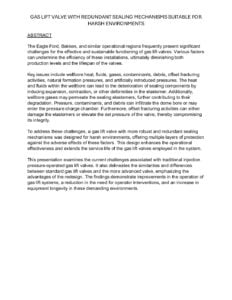Gas Lift Valve with Redundant Sealing Mechanisms Suitable for Harsh Environments
by:
Daniel Murski – Liberty Lift
ABSTRACT
The Eagle Ford, Bakken, and similar operational regions frequently present significant challenges for the effective and sustainable functioning of gas lift valves. Various factors can undermine the efficiency of these installations, ultimately diminishing both production levels and the lifespan of the valves.
Key issues include wellbore heat, fluids, gases, contaminants, debris, offset fracturing activities, natural formation pressures, and artificially introduced pressures. The heat and fluids within the wellbore can lead to the deterioration of sealing components by inducing expansion, contraction, or other deformities in the elastomer. Additionally, wellbore gases may permeate the sealing elastomers, further contributing to their degradation. Pressure, contaminants, and debris can infiltrate the dome bore or may enter the pressure charge chamber. Furthermore, offset fracturing activities can either damage the elastomers or elevate the set pressure of the valve, thereby compromising its integrity.
To address these challenges, a gas lift valve with more robust and redundant sealing mechanisms was designed for harsh environments, offering multiple layers of protection against the adverse effects of these factors. This design enhances the operational effectiveness and extends the service life of the gas lift valves employed in the system.
This presentation examines the current challenges associated with traditional injection pressure-operated gas lift valves. It also delineates the similarities and differences between standard gas lift valves and the more advanced valve, emphasizing the advantages of the redesign. The findings demonstrate improvements in the operation of gas lift systems, a reduction in the need for operator interventions, and an increase in equipment longevity in these demanding environments.

